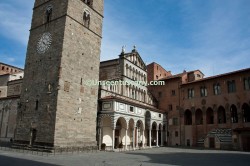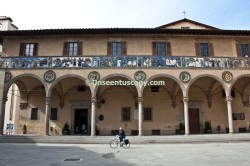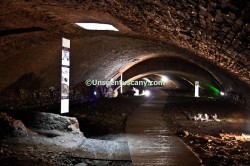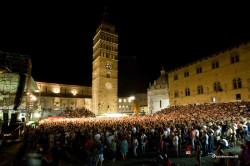 Pistoia (liet. Pistoja), nors ir visai netoli Florencijos, retai kada patenka į turistų žemėlapius ir įdomių topus, o dažniausiai minimi tik du faktai – apylinkėse įsikūrę nesibaigiantys daigynai, kurie matyti važiuojant greitkeliu, ir legenda apie tai, kad žodis „pistoletas“ kilo iš miesto pavadinimo. Tačiau įdomiausi lankytini objektai Pistoios mieste – kiti ir tikrai verti dėmesio.
Pistoia (liet. Pistoja), nors ir visai netoli Florencijos, retai kada patenka į turistų žemėlapius ir įdomių topus, o dažniausiai minimi tik du faktai – apylinkėse įsikūrę nesibaigiantys daigynai, kurie matyti važiuojant greitkeliu, ir legenda apie tai, kad žodis „pistoletas“ kilo iš miesto pavadinimo. Tačiau įdomiausi lankytini objektai Pistoios mieste – kiti ir tikrai verti dėmesio.
Pistoia – sena, kelis tūkstančius metų skaičiuojanti gyvenvietė, galų, ligūrų ir etruskų valdų dalis, na o vėliau priklausė romėnams. 1177 metais pistoiečiai apsitvėrė galinga mūro siena ir išsirinko nepriklausomą miesto valdžią. Vėliau Pistoios nepasidalino Florencija ir Lucca. Beje, Dieviškojoje komedijoje Pistoią minėjo Dantė, o Michelangelo, matyt, nelabai mėgo šį miestą, tad pistoiečius vadino dangaus priešais.
Lankytini objektai
 Legenda pasakoja, kad vienos speiguotos ir snieguotos žiemos metu stebuklingai pražydo kelmas, toje vietoje pasirodė šv. Mergelė Marija ir dievobaimingiems sutuoktiniams Antimo ir Bendinellai nurodė pastatyti ligoninę. 1277 m. Pistoios mieste ligoninė iš tiesų buvo pastatyta, o bėgant metams miestiečių aukų dėka čia atsirado vidinis kiemas, oratoriumas ir moterims skirtos patalpos. Iki šiol išliko XV amžiuje statyta ligoninės dalis, labai panaši į Florencijos L’Ospedale degli Innocenti. Lodžijos frizas puoštas spalvotai glaistyta terakotos juosta ir medalionais. Pastarųjų autorius yra garsaus Florencijos meistro Andrea della Robbia sūnus Giovanni.
Legenda pasakoja, kad vienos speiguotos ir snieguotos žiemos metu stebuklingai pražydo kelmas, toje vietoje pasirodė šv. Mergelė Marija ir dievobaimingiems sutuoktiniams Antimo ir Bendinellai nurodė pastatyti ligoninę. 1277 m. Pistoios mieste ligoninė iš tiesų buvo pastatyta, o bėgant metams miestiečių aukų dėka čia atsirado vidinis kiemas, oratoriumas ir moterims skirtos patalpos. Iki šiol išliko XV amžiuje statyta ligoninės dalis, labai panaši į Florencijos L’Ospedale degli Innocenti. Lodžijos frizas puoštas spalvotai glaistyta terakotos juosta ir medalionais. Pastarųjų autorius yra garsaus Florencijos meistro Andrea della Robbia sūnus Giovanni.
Medicinos mokymas vyko čia pat – Ceppo ligoninėje. Paskaitos pradėtos skaityti nuo XVI amžiaus pradžios, o oficialiai Pistojos medicinos mokykla įkurta 1666 metais. Studijos trukdavo šešerius metus, veikė praktinės medicinos, chirurgijos, anatomijos, praktinių atvejų, operacijų ir ginekologijos katedros. Čia buvo įkurtas ir taip vadinamasis „anatomijos teatras“ – amfiteatro stiliaus, su palei sienas kylančiais suolais patalpa, kurioje vykdavo anatomijos paskaitos. 1844 metais mokykla buvo uždaryta dėl nepakankamo studentų skaičiaus. Dabar Pistojos ligoninėje galima aplankyti chirurginių instrumentų ir vaistinės laboratorijos ekspozicijas. Na o laboratorijoje saugomi senieji prietaisai medikamentams gaminti ir saugoti.
 Taip pat galima aplankyti po ligonine ir po miesto gatvėmis besidriekiančius senuosius miesto tunelius.
Taip pat galima aplankyti po ligonine ir po miesto gatvėmis besidriekiančius senuosius miesto tunelius.
S. Zeno katedra – romaninio stiliaus svarbiausia miesto bažnyčia viduje saugo ypatingai brangų sidabro altorių, aštuonkampę balto ir žalio marmuro krikštyklą
Dėmesio verti ir miesto rotušės rūmai, vyskupų rūmai, teismo rūmai, grakštus bokštas Torre di Catilina. Iš pagrindinės miesto aikštės viduramžiais pajudėdavo piligrimai į Santiago de Compostella mietą Ispanijoje, čia ir dabar vyksta svarbiausios pistojiečių šventės ir iškilmės, o trečiadienio ir šeštadienio rytais įsikūria turgus. Piazza della Sala aikštė, senoji prekybinė miesto širdis, kurioje dabar įsikūręs vaisių ir daržovių turgus. Spirito Santo bažnyčioje saugomas Bernini sukurtas altorius.
Renginiai
 Pirmasis iš jų – Giostra dell‘Orso šventė, vykstanti liepos 25 dieną miesto globėjo šv. Jokūbo garbei. Likus trims dienoms vyksta šventojo Jokūbo aprengimo šventė – ant statulos uždedamas raudonas apsiaustas, o ji pati užkeliama ant katedros fasado ir būna čia visos šventė metu. Giostra dell‘Orso – tai senovinės žirgų lenktynės žeme padengtoje katedros aikštėje, vykstantis tarp keturių miesto rajonų (rioni). Varžybų pavadinimas kilo iš miesto herbo, kuriame pavaizduotas lokys, dar vadinamas „micco“. Varžybų proga miestas neatpažįstamai pasikeičia – liepos 25-osios rytą senamiesčio gatvėmis nusidriekia senoviniais kostiumais pasipuošusių pistojiečių eisena, vėliau vyksta mišios, kurių metu katedroje eksponuojamos šv. Jokūbo relikvijos, galiausiai vakare vyksta žirgų varžybos.
Pirmasis iš jų – Giostra dell‘Orso šventė, vykstanti liepos 25 dieną miesto globėjo šv. Jokūbo garbei. Likus trims dienoms vyksta šventojo Jokūbo aprengimo šventė – ant statulos uždedamas raudonas apsiaustas, o ji pati užkeliama ant katedros fasado ir būna čia visos šventė metu. Giostra dell‘Orso – tai senovinės žirgų lenktynės žeme padengtoje katedros aikštėje, vykstantis tarp keturių miesto rajonų (rioni). Varžybų pavadinimas kilo iš miesto herbo, kuriame pavaizduotas lokys, dar vadinamas „micco“. Varžybų proga miestas neatpažįstamai pasikeičia – liepos 25-osios rytą senamiesčio gatvėmis nusidriekia senoviniais kostiumais pasipuošusių pistojiečių eisena, vėliau vyksta mišios, kurių metu katedroje eksponuojamos šv. Jokūbo relikvijos, galiausiai vakare vyksta žirgų varžybos.
Pistoia garsėja ir muzikos festivaliais, ypač Pistoia Festival ir Pistoia Festival Blues. Jie vyksta visą liepos mėnesį istorinėse vietose ir po atviru dangumi. Pasirinkimas čia tikrai didelis – muzika, kinas, literatūros skaitymai. Tačiau svarbiausia festivalio dalis paskutiniąją liepos savaitę – tai pasaulyje spėjęs išgarsėti Pistoia Festival Blues. Tai trys dienos bliuzo katedros aikštėje, po atviru Toskanos dangumi. Per daugiau nei tris dešimtmečius ant scenos čia lipo Muddy Waters, BB King, Frank Zappa, David Bowie, Bob Dylan, John Lee Hooker, Lou Reed, Carlos Santana, Ray Charles, Patti Smith, Miriam Makeba, Pino Daniele, Zucchero, Van Morrison, Jackson Browne, Deep Purple, Lanny Kravitz ir daugybė kitų atlikėjų.
Tiems, kam prie širdies muzika, neturėtų praleisti ir kitos iniciatyvos, vadinamos Festival Sentieri Acustici, kuri suteikia galimybę muzikos klausytis nemokamai Pistojos provincijos mieteliuose ir kaimeliuose. Bene gražiausia festivalio dalis – finalinė savaitė, kai world music stilius skamba Pistoją supančiuose kalnuose.

